Search the Special Collections and Archives Portal
Search Results
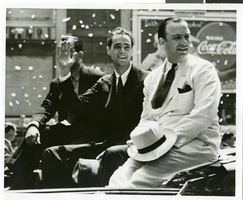
Photograph of a parade procession for Howard Hughes, New York, July 15, 1938
Date
1938-07-15
Archival Collection
Description
Typed onto a piece of paper attached to the image: new York Hails Hughes and Companions, New York City --- In the greatest reception since Lindbergh's, Howard Hughes and his four gallant companions paraded up Broadway July 15 almost smothered beneath Manhattan's ticker tape accolade recognizing their record-smashing Round-the-World flight. This picture shows Hughes, center, waving to the cheering thousands. On the left is Grover Whalen, commissioner of the New York 1939 World's Fair and on the right is Al Lodwick, Hughes' flight manager. 7-15-38. Credit Line (ACME)."
Image
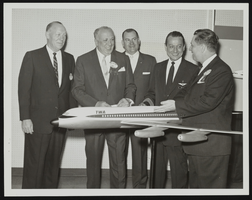
Howard Cannon discusses the Convair 880 Super Jet with Captain Ed Hall and three other men: photographic print
Date
1961-03
Archival Collection
Description
From the Howard Cannon Photograph Collection (PH-00192). Stamped on verso: "Las Vegas News Bureau - Las Vegas, Nevada Convention Center - Photographers Don English, Joe Buck, Jerry Abbott, Milt Palmer"
Image
Report: "Study of Betting on Sports in New York City" by the Fund for the City of New York Quayle Survey
Level of Description
File
Archival Collection
Eugene Martin Christiansen Papers
To request this item in person:
Collection Number: MS-00561
Collection Name: Eugene Martin Christiansen Papers
Box/Folder: Box 168
Collection Name: Eugene Martin Christiansen Papers
Box/Folder: Box 168
Archival Component
"The New York City Office of the Comptroller Discussion Materials Regarding New York City OTB", 2007
Level of Description
File
Archival Collection
Eugene Martin Christiansen Papers
To request this item in person:
Collection Number: MS-00561
Collection Name: Eugene Martin Christiansen Papers
Box/Folder: Box 069
Collection Name: Eugene Martin Christiansen Papers
Box/Folder: Box 069
Archival Component
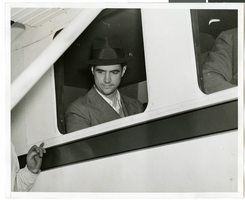
Photograph of Howard Hughes in the Lockheed 14, New York, July 10, 1938
Date
1938-07-10
Archival Collection
Description
Howard Hughes sitting inside the Lockheed 14 aircraft in New York. Typed on a piece of paper attached to the image: "Hughes' Paris hop delayed by motor trouble. New York City-- Howard Hughes, millionaire oil man and speed flyer, in the cabin of his huge Lockheed plane as he waited impatiently for a crew of mechanics to repair one of the motors so that he could take off for Paris. He was forced to give up his plans to leave on July 9th when mechanics found that it would be impossible to change the 18 cylinders of his motors in time. Crews worked all night at the job. Rough spots were found in the cylinders during fuel consumption tests. Credit Line (ACME) 7/10/38 Burs SF."
Image
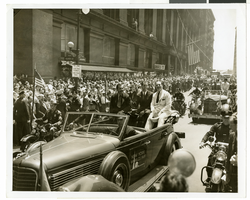
Photograph of Howard Hughes and crew at a parade, New York, July 15, 1938
Date
1938-07-15
Archival Collection
Description
Description printed photograph's accompanying sheet of paper: "Howard Hughes in car receiving the applause of the crowd during his reception in New York. 7-15-38."
Image

Photograph of Howard Hughes and other men in New York, August 20, 1938
Date
1938-08-20
Archival Collection
Description
Description given with photograph: "Howard Hughes after landing in New York after a high altitude flight from Los Angeles during which he tested a new two-ounce oxygen mask. With him were (L to R): Charles Perrine, Glenn Odekirk, and Harry Connor."
Image
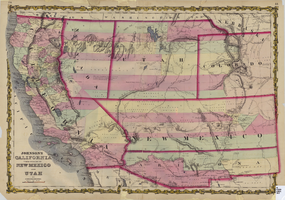
Map of California and territories of New Mexico and Utah, circa 1861
Date
1856 to 1866
Description
40 x 60 cm. Relief shown by hachures and spot heights. Prime meridians: Greenwich and Washington. Atlas plate numbers 54 and 55 in the upper corners. Shows forts, trails, exploration routes, drainage, mail steamship routes, physical features, Indian tribes, and historic sites. The geographic region of Southwest is referred to as the New Southwest. Original publisher: Johnson .
Image
Pagination
Refine my results
Content Type
Creator or Contributor
Subject
Archival Collection
Digital Project
Resource Type
Year
Material Type
Place
Language
Records Classification


